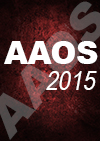
AAOS 2015: Platelet-rich plasma vs hyaluronic acid for knee osteoarthritis

AAOS 2015: Platelet-rich plasma vs hyaluronic acid for knee osteoarthritis
HA vs. PRP: Double-blind RCT Comparing Clinical Outcomes and Intra-articular Biology for Knee Arthritis Treatment
Did you know you're eligible to earn 0.5 CME credits for reading this report? Click Here
CONFERENCE ACE REPORTS
This ACE Report is a summary of a conference presentation or abstract. The information provided has limited the ability to provide an accurate assessment of the risk of bias or the overall quality. Please interpret the results with caution as trials may be in progress and select results may have been presented.
Synopsis
111 patients with knee osteoarthritis were randomized to receive either intra-articular hyaluronic acid (HA) or platelet-rich plasma (PRP) injections. The purpose of this study was to compare clinical and biological measures between treatments. Both groups received three weekly injections. Patient-report outcome measures, clinical examination, and synovial aspirate analysis were assessed over 24 w...
To view the full content, login to your account,
or start your 30-day FREE Trial today.
FREE TRIAL
LOGIN
Forgot Password?
Explore some of our unlocked ACE Reports below!

Learn about our AI Driven
High Impact Search Feature
Our AI driven High Impact metric calculates the impact an article will have by considering both the publishing journal and the content of the article itself. Built using the latest advances in natural language processing, OE High Impact predicts an article’s future number of citations better than impact factor alone.
Continue



 LOGIN
LOGIN

Join the Conversation
Please Login or Join to leave comments.